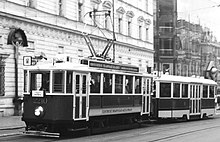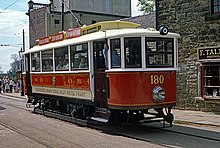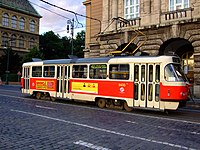Trams in Prague
This article may be expanded with text translated from the corresponding article in Czech. (March 2009) Click [show] for important translation instructions.
|
 Prague Škoda 15 T tram in Dejvice | |||
 Prague Tatra T3R.P tram in front of the Dancing House | |||
| Overview | |||
|---|---|---|---|
| Locale | Prague, Czech Republic | ||
| Transit type | Tramway | ||
| Number of lines | 34 (25 day routes, 9 night routes)[1](as of 25.3.2017) | ||
| Number of stations | 600 | ||
| Annual ridership | 373.5 million (2018)[2] | ||
| Website | Dopravní podnik hlavního města Prahy | ||
| Operation | |||
| Began operation | 1875 (horse)[3] 1891 (electric)[3] | ||
| Operator(s) | Dopravní podnik hlavního města Prahy (English: ) | ||
| Technical | |||
| System length | 518 km (322 mi) – total route length[1] 142.4 km (88.5 mi) – track length[1] | ||
| Track gauge | 1,435 mm (4 ft 8+1⁄2 in) standard gauge | ||
| Electrification | Overhead line (600 V DC) | ||
| |||
The Prague tramway network is the largest tram network in the Czech Republic, consisting of 142.4 km (88.5 mi) of track,[1][4] 882 tram vehicles (one of the largest fleets in the world)[5] and 26 daytime routes, 2 historical and 9 night routes[1] with a total route length of 518 km (322 mi).[1] It is operated by Dopravní podnik hlavního města Prahy a.s., a company owned by the City of Prague. The Prague tram system (including the Petřín funicular) served 373.4 million passengers in 2018,[2] the highest number in the world after Budapest. Prague's first horsecar tram line was opened in 1875, and the first electric tram ran in 1891.[3]
Prague trams today[]


As of 25 March 2017, the Prague tram network includes:
- 25 day routes (numbered 1 to 26) - route 23 is operated as nostalgic by old unmodernised Tatra T3 trams, but due to the pandemic it's not in operation
- 9 night routes (numbered 91 to 99, before 29 April 2017 numbered 51 to 59) and
- 2 historical route, number 42 and 43.
The day lines run from 4:30 AM until 1:00 AM the next day. Most of the lines run everyday from early morning to late night. Some lines also only run at selected times (usually workdays) and/or rush hours.

Night trams[]
Night trams operate between midnight and 5:00 or 6:00. Their routes are different from the daily ones, since in the night the trams have to substitute for the Metro. All lines converge at Lazarská in the city centre, although other interchanges exist. At Lazarská, passengers can change between all routes within 5 minutes, although individual services only run once every 30 minutes. Trams operating on the night lines start their shifts at about 8:00 PM on normal day lines, changing their routes at midnight and returning to their depots at the start of normal operations.
History[]
Horse tram[]

The horsecar trams started to operate on 23 September 1875 along the route Karlín - National Theater. The owner and the entrepreneur of this road was Eduard Otlet, from Belgium. This way lead to the theater, along the Národní Třída street. Tracks went approximately in direction of today's Metro Line B. In 1876, the track was extended west of the National Theater, through the Újezd hub to the Smíchov Railway Station. In 1882 the network was extended to Vinohrady and Žižkov. At that time, they were independent suburbs of Prague, but now they are incorporated into city. In 1883, the size of the entire network was 19.43 kilometers.
Electric trams[]

In 1891 the first electric tram line was opened in Letná, a popular place of recreation in Prague. This line (cs) led from the upper terminal of the Letná funicular (cs) to the pavilion of the Jubilee Exhibition through Ovenecká street. After two more years, this line was extended to the Governor's Villa (cs), a further distance of 1.4 km. In 1896, on 19 March, František Křižík opened a second, more important tram line, which lead from Florenc to Libeň and , joining the industrial suburbs of Prague with its residential area in the center.
In a continuation of the rapid growth of Prague's trams, another new lined was opened in 1897. This time it was a suburban route from Smíchov to Košíře. It was named "Hlaváčkova electric railway". Later, a new passenger railroad in Královské Vinohrady was opened. The Prague to Vinohrady stretch spanned 5.8 kilometers, had 17 stations, and passed through Nové město (New Town).
At another side of the city, thanks to above-listed railway between Anděl and Smíchov, it allowed Prague tram to provide one-seat-ride between Košíře and Vinohrady. Eventually, the municipal enterprise, Prague Transportation Company, was formed.
In 1898 the horse railway was bought by the company. Due to this, construction of new track started along with electrification of the existing tracks.
Early 20th century[]


In the early 20th century, a monopoly was formed to provide transportation in the city. It began to electrify the horse tram and soon the Otlet Prague trams came under the control of competitors of the electric enterprises. As the monopoly grew, it took over the tracks of the rest of its private competitors. The last private track, the work of František Křižík, was transferred to the city by the year of 1907. In 1905, the electrification works were finished. Even the last horse tram route through the Charles Bridge was electrified (also a project of František Křižík). The tram route through the Charles Bridge operated until 1908.
World War One[]

The war added new strain to the tram network. A lack of sufficient horse-drawn transport meant that trams were used to carry war materials, fuel, raw materials, and food. Additionally, the need for ammunition led to trams being melted down for their metal and used to produce grenades and bombs, leading to further fall in capacities. This pressure came to an end when the newly formed First Czechoslovak Republic signed a peace treaty.
First republic[]
Again, the tram network underwent expansion, mainly to the newly built quarters of the expanded metropolitan Prague, such as Dejvice, Nusle and Žižkov. In 1927 the length of the network exceeded 100 km. At that time the new unidirectional tram types were introduced and the dead-end terminals were rebuilt into loops.
Post-war era[]

In 1951 began the replacement of two-axle tram railcars, by new modern series of ČKD production, at first by Tatra T1 and since 1962 by Tatra T3.
In the 1960s, construction began on first underground sections of Prague's tram network. While the works were already underway, the project was changed to become a full metro system and the trams were expected to gradually phase-out similarly to most of the western cities. In this time, several important track sections were removed, including the line on Wenceslas Square.
However, in the 1980s, the Communist government understood the advantages of a modern tram system and began ordering new tramcars, such as the Tatra KT8D5 as well as more Tatra T3, and started constructing new track sections, most of which were completed soon after the Velvet Revolution. There weren't many new tracks opened during the first 20 years after the revolution, since much more attention was paid to modernizations of existing tracks and vehicles, causing major service disruptions every summer.
Among the new tracks that has been the constructed are extensions to Sídliště Řepy (1988), Ohrada-Palmovka (1990), to Modřany (1995), Hlubočepy–Sídliště Barrandov (2003), Laurová–Radlická (2008), Vítězné náměstí–Podbaba (2011) and Pražského povstání–Pankrác (2021).
Planned network development[]
Many track extensions are nowadays included in the development plans: Hlavní nádraží–Vinohrady, Divoká Šárka–Dědina, Sídliště Barrandov–Holyně–Slivenec and Modřany–Libuš.[6]
Infrastructure[]

The network has seven active depots:[7]
Another depot, , no longer runs an active service, but houses the .
Rolling stock[]
The Prague public transport company has currently available for standard operations a sizable fleet of 968 trams of varying types, ranging from the classic Tatra T3 cars to the modern Škoda 15 T low-floor trams. These trams are distributed across seven depots across the city. Besides these, the company owns also a fleet of heritage streetcars kept within the transport museum and several trams especially equipped for use for driver training or snowplowing, bringing the total number of vehicles to over 1,000.
Tatra T3 and modifications[]


The various modifications of the Tatra T3 tram cars, which are common all over the former Eastern bloc, form the bulk of the fleet, since they were produced in Prague in large numbers for both domestic use and export. More than half of the classic streetcars have undergone modernization during the first ten years of the 21st century, which equipped them with new motors and electrical equipment, new audiovisual information system for the passengers and refurbished interiors. The renovated trams were named Tatra T3R.P, where R stands for Renovated and P for the used electrical equipment. Both the original design and the modernizations have proved so successful that the transport company has decided to produce newly built trams according to the original design, but with a low-floor section in the middle.
Newer trams[]
In the eighties, it was decided to produce a higher-capacity tram vehicle. The result was the Tatra KT8D5 articulated tramcar, of which 49 were delivered. All of these were modernized and equipped with a low-floor section. After the Velvet Revolution, the company decided not to continue with the deliveries and instead ordered delivery of 150 standard-length Tatra T6A5 cars. Shortly after these deliveries ended, the traditional producer of trams for Prague, ČKD Tatra, went bankrupt, stopping new tram deliveries for several years.
After strong demands both from the handicapped community and from the general public, the Prague transport company decided to order new low-floor trams from Škoda Transportation. 60 Škoda 14 T trams, designed by Porsche, were delivered between 2005 and 2009. They were followed by 250 of a more modern 100% low-floor Škoda 15 T since 2010.
Current rolling stock[]
| Image | Tram Car Type | Modifications and subtypes | Bidirectional? | Fleet numbers | Depot Allocations | In service[8] |
|---|---|---|---|---|---|---|

|
Tatra T3 | No | T3 67xx–69xx (withdrawn) T3SU 7001–7020 T3SUCS 7021–7292 T3M 8005–8106 T3RP 8211–8245, 8300–8554, T3R.PV 8151–8181 T3R.PLF 8251–8258 |
Hloubětín, Pankrác, Strašnice, Kobylisy, Vokovice, Žižkov | 426 | |

|
Tatra KT8D5 | Yes | 9001–9048 non-modernized (without 9006 - damaged) 9051–9097 modernized. When a tram gets modernized 50 is added to its number. Now they are gradually upgraded from type KT8D5 to type KT8D5R.N2P purchased trams from Miskolc, which is 15 and 4 are already in operation (9099-9102[clarification needed] |
Hloubětín | 52 | |

|
Škoda 14 T | Škoda 14 T | No | 9111–9170 | Kobylisy | 55 |

|
Škoda 15 T | Škoda 15 T (15T Alfa) |
No | 9201–9325 9326–9450 |
Pankrác, Vokovice, Motol, Žižkov | 250 |
See also[]
- List of tram and light rail transit systems
- Petřín funicular
- Prague Metro
- Vinohrady tram depot
- Buses in Prague
References[]
- ^ a b c d e f "Company Profile - Dopravní podnik hlavnívo města Prahy". Dopravní podnik hlavnívo města Prahy. Retrieved 11 September 2013.
- ^ a b "Ročenka dopravy Praha 2018" (PDF). tsk-praha.cz (in cs-CZ). Technická správa komunikací hlavního města Prahy a.s. p. 18.
{{cite web}}: CS1 maint: unrecognized language (link) - ^ a b c "History - Dopravní podnik hlavnívo města Prahy". Dopravní podnik hlavnívo města Prahy. Retrieved 11 September 2013.
- ^ "Annual Report 2011" (PDF). DPP.cz. Dopravní podnik hlavnívo města Prahy. p. 22. Retrieved 21 February 2013.
- ^ Vehicle Statistics
- ^ "Tramvajové tratě". Strategickeprojekty.dpp.cz (in cs-cz). Retrieved 30 July 2018.
{{cite web}}: CS1 maint: unrecognized language (link) - ^ "Každý den odtud vyjede 50 tramvají. Vozovna Žižkov slouží 100 let". idnes.cz (in Czech). 28 April 2012. Retrieved 21 November 2013.
- ^ Praha, Tramway
External links[]
| Wikimedia Commons has media related to Tram transport in Prague. |
- Public transport in Prague
- Tram transport in the Czech Republic
- Town tramway systems by city
